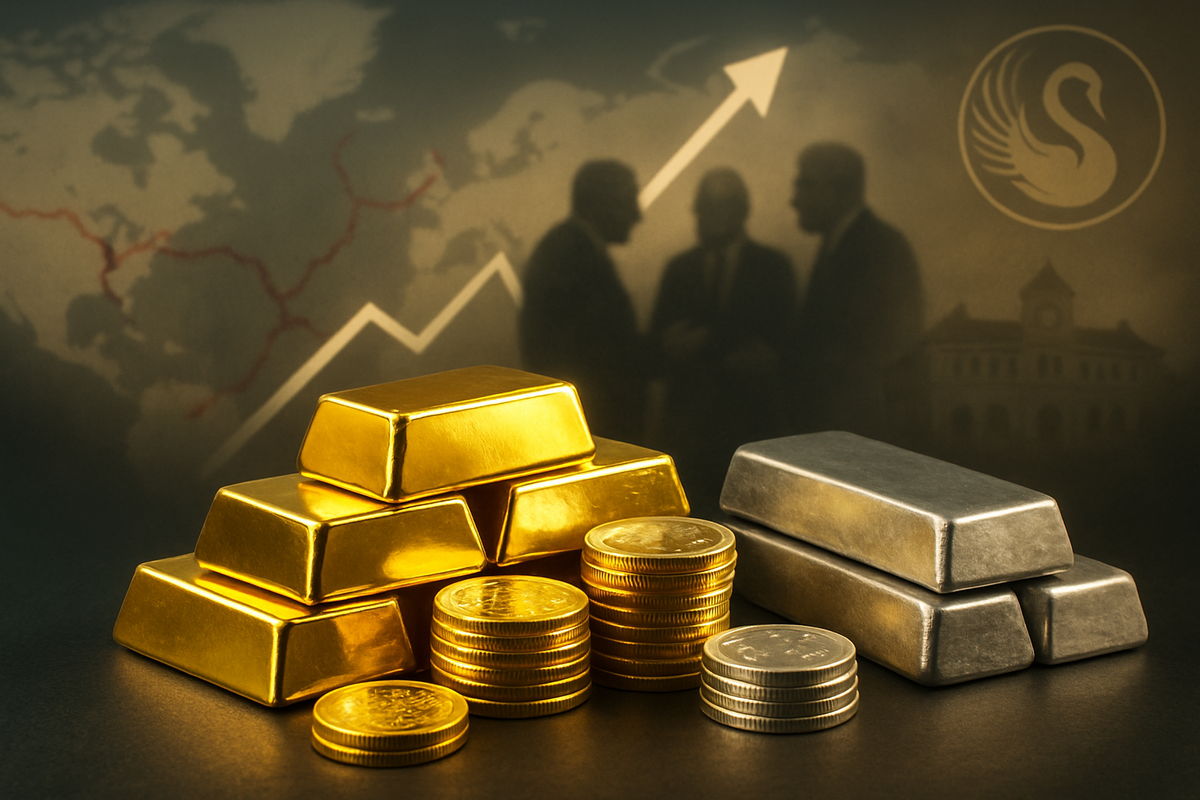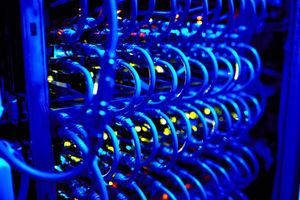
Gold and silver prices have shattered historical records in October 2025, signaling a profound shift in investor sentiment amidst escalating global economic and geopolitical uncertainties. Gold has surged past $4,300 per ounce, while silver has emphatically broken the $54 per ounce barrier, marking year-to-date gains exceeding 60% and 80% respectively. This unprecedented rally underscores a global flight to safety, with precious metals reasserting their role as critical safe-haven assets in turbulent times. The immediate implication is an accelerated "risk-off" sentiment across financial markets, prompting a significant re-evaluation of traditional portfolio allocations and potentially triggering a rotation of capital out of riskier assets.
This dramatic surge is driven by a confluence of powerful factors. Persistent geopolitical tensions in the Middle East and Europe, renewed US-China trade friction, and domestic US economic anxieties—including concerns over government shutdowns and the ballooning national debt exceeding $37.85 trillion—are pushing investors towards tangible assets. Furthermore, the Federal Reserve's dovish monetary policy, with a 25-basis-point rate cut in September 2025 and further cuts anticipated, has significantly weakened the US dollar. The DXY index's 10-11% depreciation in the first half of 2025 has made dollar-denominated precious metals more attractive to international buyers and reduced the opportunity cost of holding non-yielding assets.
Silver, in particular, is experiencing a dual-fueled rally, benefiting from both investment demand and booming industrial consumption. The global energy transition, particularly the rapid expansion of solar panels and electric vehicles, coupled with surging demand from electronics and emerging AI technologies, has led to a structural supply deficit for the fifth consecutive year. Most silver is a byproduct of other metal mining, making it difficult to ramp up production quickly to meet this spiking demand. Central banks, especially in emerging markets like China, India, and Turkey, are also accumulating gold at the fastest pace in decades, diversifying away from the US dollar and providing a robust floor for prices. India's gold imports alone reached $9.615 billion in September 2025, a 110% increase year-over-year.
Institutional investors are also recalibrating their strategies, with some major financial institutions advocating for increased gold allocations, such as Morgan Stanley's Chief Investment Officer suggesting a "60/20/20" model (60% equities, 20% bonds, 20% gold). Acute physical silver shortages in major markets like London and New York, soaring lease rates, and significant backwardation further highlight the severe supply-demand imbalances. This intense market activity brings into sharp focus key players in the precious metals industry, with the Perth Mint emerging as a particularly significant entity given its global reputation and role in providing trusted physical precious metal products. The unprecedented rally, while exciting, also comes with warnings of increased volatility as prices navigate uncharted territory.
The Perth Mint: A Beacon of Trust in Turbulent Times
The current precious metals surge undeniably shines a spotlight on institutions like the Perth Mint, which stands as a globally renowned and uniquely positioned player in the market. Established in 1899 as a branch of the UK's Royal Mint during Australia's gold rushes, the Perth Mint (ASX: PMGOLD, indirectly through its exchange-traded product) has evolved into Australia's largest fully integrated precious metals enterprise. Its enduring appeal stems from a government guarantee by the State of Western Australia, offering unparalleled security and trust to investors worldwide. This assurance, combined with its reputation for exceptional quality, purity (producing 99.99% pure gold and silver products), and meticulous craftsmanship, makes its bullion products highly sought after during periods of economic uncertainty.
The Mint's refinery holds top accreditations from major global exchanges, including the London Bullion Market Association (LBMA), the New York Commodity Exchange, and the Tokyo Commodity Exchange, solidifying its status as a trusted source for both gold and silver. It refines approximately 79% of Australasia's gold production and 30% of its silver, contributing about 10% to global gold production. Beyond its refining prowess, the Perth Mint is celebrated for its diverse range of investment products, including iconic Australian legal tender bullion coins like the Kangaroo, Kookaburra, and Koala series, as well as minted and cast bars. These products are not only recognized for their purity but also for their liquidity, making them easily traded by investors and dealers globally.
The surge in gold and silver prices has directly translated into heightened activity for the Perth Mint. In August 2025, for instance, the Mint reported a 38% month-on-month increase in gold coin and bar sales, driven by robust wholesale demand and new product releases. This uptick underscores the Mint's role as a primary beneficiary when investors flock to safe-haven assets. While silver sales have shown more volatility, reflecting its dual role as an industrial and investment metal, periods of strong investor confidence still see healthy growth in the Mint's silver product sales. The Perth Mint's sales figures serve as a crucial barometer of market sentiment, reflecting how global economic and geopolitical conditions influence investment strategies and the demand for physical precious metals.
Winners, Losers, and Market Ripple Effects
The current precious metals rally creates clear winners and poses significant challenges for others in the financial ecosystem. Unsurprisingly, precious metals miners and refiners are among the primary beneficiaries. Companies like Newmont Corporation (NYSE: NEM), Barrick Gold Corporation (NYSE: GOLD), and Wheaton Precious Metals Corp. (NYSE: WPM), which specialize in gold and silver extraction and production, stand to see substantial increases in revenue and profit margins as commodity prices soar. Their existing reserves become significantly more valuable, potentially fueling increased exploration and development activities. The Perth Mint, as a major refiner and producer of physical bullion, is also a clear winner, experiencing heightened demand for its government-guaranteed products and refining services.
Conversely, industries heavily reliant on silver as a raw material face escalating costs. Manufacturers of solar panels, electric vehicle components, and various electronic devices will see their input costs rise dramatically. Companies such as First Solar, Inc. (NASDAQ: FSLR) or those in the semiconductor industry may find their profit margins squeezed if they cannot fully pass on these increased costs to consumers. This could lead to strategic adjustments in supply chain management, material sourcing, or even a push for alternative, less expensive materials where feasible.
The broader market implications include a potential acceleration of capital rotation. As investors increasingly prioritize safe-haven assets, capital may continue to flow out of traditional equities, particularly growth stocks that thrive in stable, low-inflation environments. This shift could lead to underperformance in sectors perceived as higher risk. Furthermore, the robust demand for physical metals, particularly silver, could exacerbate supply chain pressures and lead to further price volatility, creating both opportunities for speculative trading and risks for industrial users. Investment firms with significant exposure to precious metals or those offering diversified commodity funds are likely to see increased client interest and asset under management growth.
Broader Significance and Historical Parallels
This unprecedented surge in gold and silver prices is not merely a fleeting market event; it signifies a profound recalibration of global financial dynamics and fits squarely into several broader industry trends. Most notably, it accelerates the ongoing de-dollarization efforts by central banks worldwide. Nations like China, India, and Turkey are aggressively diversifying their foreign reserves away from the US dollar, viewing gold as a more stable and independent store of value. This strategic pivot could have long-term implications for the international monetary system, fostering a more multi-polar financial landscape and potentially diminishing the dollar's global dominance.
The event also highlights a significant shift in institutional investor sentiment, moving away from the conventional 60/40 stock-bond portfolio split. Influential figures like Morgan Stanley's Chief Investment Officer are now advocating for substantial allocations to gold, suggesting a "60/20/20" model (equities/bonds/gold). This re-evaluation reflects a growing distrust in traditional financial instruments and fiat currencies, particularly in an environment of persistent inflation fears and unprecedented national debt levels. The sustained capital inflows into gold Exchange Traded Funds (ETFs) suggest that this is a strategic portfolio rebalancing rather than opportunistic trading.
Historically, such sharp increases in precious metals prices are often correlated with periods of high geopolitical instability, economic uncertainty, and inflationary pressures. The 1970s, characterized by the oil crisis, stagflation, and the abandonment of the gold standard, saw gold prices skyrocket. More recently, the 2008 financial crisis and the early stages of the COVID-19 pandemic also triggered significant safe-haven buying. The current environment, with simultaneous global conflicts, inflationary concerns, and unprecedented national debt, presents a potent cocktail reminiscent of these historical precedents, reinforcing gold and silver's traditional role as hedges against systemic risk. Regulatory bodies might also begin to scrutinize the physical precious metals market more closely, especially given the reported shortages and backwardation in silver, to ensure market integrity and prevent potential manipulation.
The Road Ahead: Navigating a Shifting Landscape
Looking ahead, the precious metals market is poised for continued volatility and significant strategic shifts. In the short term, the momentum behind gold and silver suggests further price appreciation, with analysts from major financial institutions like Bank of America, JPMorgan, Goldman Sachs, and HSBC now forecasting gold to potentially reach $5,000 per ounce and silver to hit $60-$65 per ounce by 2026. This optimistic outlook is fueled by ongoing geopolitical tensions, anticipated further Federal Reserve rate cuts, and persistent industrial demand for silver. Investors should brace for price swings but also recognize potential entry points during any temporary pullbacks.
In the long term, the structural drivers supporting precious metals appear robust. The ongoing de-dollarization trend, coupled with central bank accumulation, provides a strong floor for gold prices. For silver, the relentless demand from the green energy transition (solar, EVs) and emerging technologies (AI, electronics) ensures a sustained industrial appetite, which, combined with supply constraints, points to a continued bullish trajectory. Companies in the precious metals sector may strategically pivot towards increasing production capacity and enhancing their refining capabilities to meet this surging demand. The Perth Mint, for instance, could see opportunities to expand its refining operations and diversify its product offerings to capture a larger share of the growing investment market.
Market opportunities will emerge for investors willing to embrace a diversified portfolio that includes a significant allocation to precious metals. Beyond physical bullion, well-managed precious metals ETFs and mining stocks could offer leveraged exposure to price movements. Challenges, however, include managing the inherent volatility, assessing the sustainability of industrial demand for silver, and navigating potential regulatory changes that could impact trading or ownership of physical metals. Potential scenarios range from a continued, steady ascent of prices driven by sustained demand and geopolitical stability, to more rapid spikes if global crises intensify, or even corrections if economic conditions unexpectedly stabilize and risk appetite returns to traditional assets.
A New Era for Precious Metals
The recent, dramatic surge in gold and silver investments marks a pivotal moment in financial markets, signaling a fundamental shift in how investors and central banks perceive and utilize precious metals. The key takeaway is clear: gold and silver are reasserting their traditional roles as ultimate safe havens and hedges against inflation and geopolitical instability. This rally is not merely speculative; it is underpinned by a robust combination of geopolitical uncertainty, a weakening US dollar driven by dovish monetary policy, unprecedented industrial demand for silver, and strategic diversification by central banks.
Moving forward, the market will likely remain characterized by elevated volatility but with a strong underlying bullish sentiment. The Perth Mint, with its government-backed guarantee, reputation for purity, and comprehensive range of products, stands as a prime example of an institution benefiting from this renewed interest. Its sales figures will continue to serve as a critical barometer of investor sentiment, reflecting the ongoing global quest for security and tangible assets.
Investors should closely monitor several key factors in the coming months: further actions by the Federal Reserve regarding interest rates, the evolution of geopolitical conflicts, the pace of de-dollarization efforts by central banks, and any developments in the supply chains for industrial silver. Diversification remains paramount, and a strategic allocation to precious metals, whether through physical holdings, ETFs, or reputable mining stocks, appears increasingly prudent. This period could well signify the dawn of a new era for gold and silver, where their intrinsic value and safe-haven properties are more appreciated and sought after than ever before.
This content is intended for informational purposes only and is not financial advice





